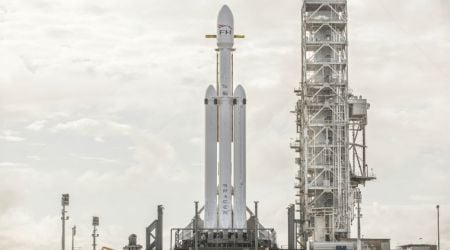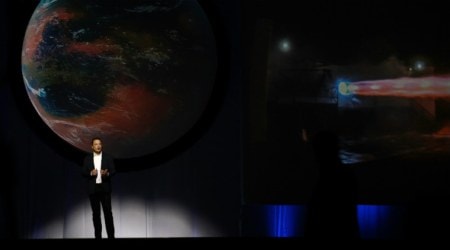 The fairing half as seen from the boat. (SpaceX)
The fairing half as seen from the boat. (SpaceX)
Early on Thursday morning, SpaceX successfully launched an Earth observation satellite from the Vandenberg Air Force Base in California using its workhorse Falcon-9 rocket. But it wasn’t a routine launch. SpaceX launched two other mini satellites into orbit to assess the viability of its CEO Elon Musk’s dream of creating the Starlink constellation — a network of satellites to deliver low-cost, high-speed internet globally. “Today’s Falcon launch carries 2 SpaceX test satellites for global broadband. If successful, Starlink constellation will serve least served.” Musk said in a tweet on February 21. The main payload of the rocket was a radar-imaging satellite built for Spain, the Paz.
Starlink is expected to have over 12,000 small satellites — more than all the satellites that have been launched in history — that will be placed in two layers of satellite constellation at a low Earth orbit (LEO) of 4,425 satellites at altitudes ranging from 1,110 km to 1,325 km, and very low Earth orbit (VLEO) of 7,518 satellites operating at altitudes from 335 km to 346 km.
 The Falcon 9 rocket launch in California on Thursday. (SpaceX)While the LEO Constellation will provide high-speed broadband service around the world, the VLEO Constellation is expected to enhance capacity by being able to focus on a narrower area.
The Falcon 9 rocket launch in California on Thursday. (SpaceX)While the LEO Constellation will provide high-speed broadband service around the world, the VLEO Constellation is expected to enhance capacity by being able to focus on a narrower area.
SpaceX also achieved another milestone on Thursday, when it recovered at least one of the fairings — the nosecone on top of the rocket that covers the payload.
It is usually not recovered after a mission but this time, SpaceX decided to invest in getting it back. SpaceX’s mission is to make rockets fully reusable, which will reduce the cost of space exploration by at least a hundredfold.
After the launch, the nosecone separates into two fairings after it has deployed the payload. SpaceX fitted its nosecone with a parachute, which helped reduce the speed at which it returned to Earth. SpaceX placed a boat named Mr Steven at the spot the fairings were expected to splashdown, and fitted Mr Steven with a giant net to catch them. But one of the fairings landed several hundred metres away on water, though it didn’t seem to have suffered any damage.
For all the latest Technology News, download Indian Express App

























